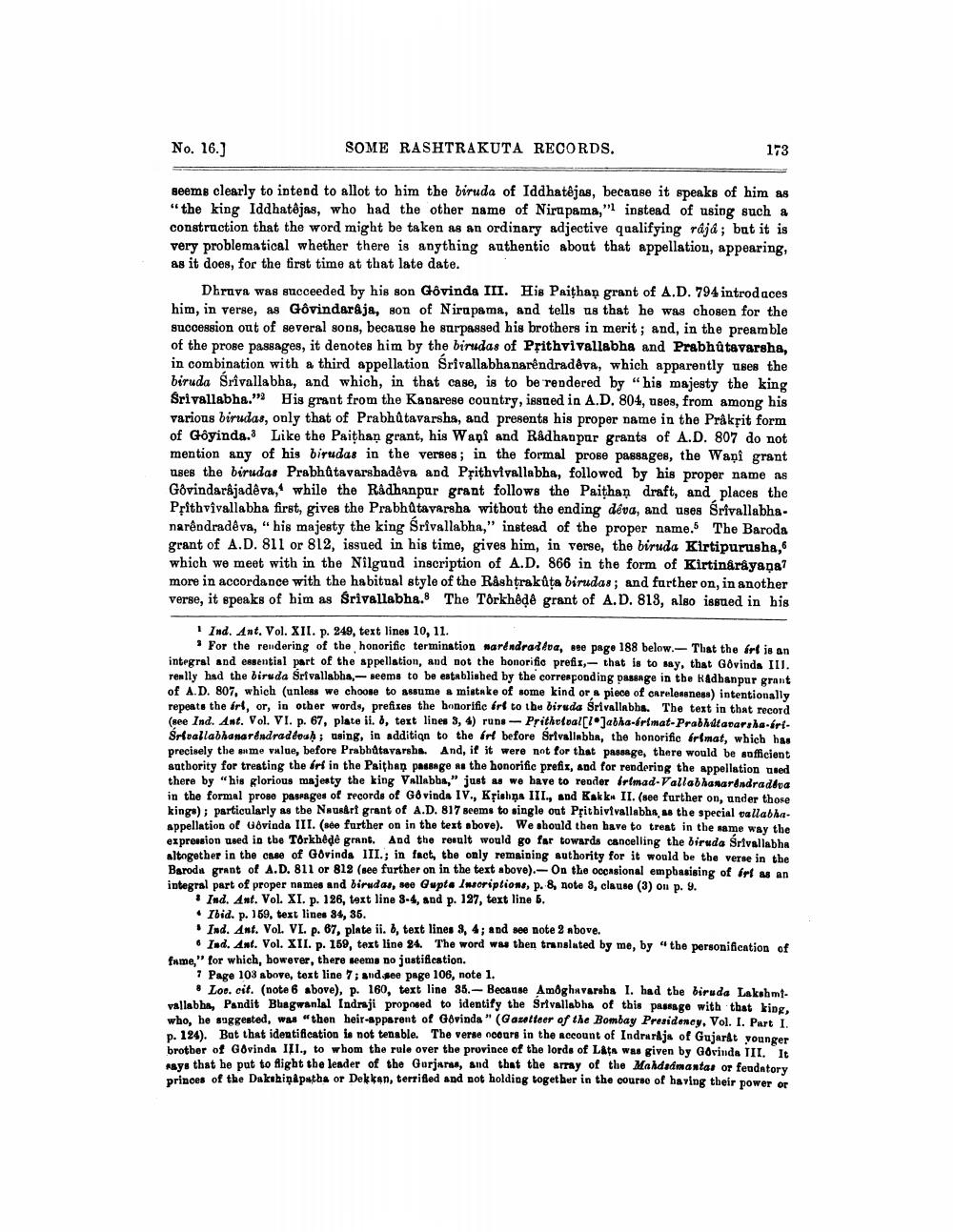________________
No. 16.)
SOME RASHTRAKUTA RECORDS.
173
seems clearly to intend to allot to him the biruda of Iddhatėjas, because it speaks of him as "the king Iddhatêjas, who had the other name of Nirupama,'' instead of using such a construction that the word might be taken as an ordinary adjective qualifying raja; but it is very problematical whether there is anything authentic about that appellation, appearing, as it does, for the first time at that late date.
Dhruva was succeeded by his son Gôvinda III. His Paithan grant of A.D. 794 introd aces him, in verse, as Gôvindaraja, son of Nirapama, and tells us that he was chosen for the succession out of several song, because he surpassed his brothers in merit; and, in the preamble of the prose passages, it denotes him by the biradas of Přithvivallabha and Prabhůtavarsha, in combination with a third appellation Srivallabha narendradêva, which apparently uses the biruda Srivallabha, and which, in that case, is to be rendered by “his majesty the king Srivallabha." His grant from the Kaparese country, issued in A.D. 804, uses, from among his various birudas, only that of Prabhůtavarsha, and presents his proper name in the Pråkpit form of Gôyinda. Like the Paithan grant, his Wani and Radhanpur grants of A.D. 807 do not mention any of his birudas in the verses; in the formal probe passages, the Wapi grant uses the birudas Prabhä tavarsbadeva and Prithvivallabha, followed by his proper name as Govindarajadêva," while the Rådhanpur grant follows the Paithan draft, and places the Prithvivallabha first, gives the Prabhutavarsha without the ending dēva, and uses Srivallabhanarendradêva, "his majesty the king Srivallabha," instead of the proper name. The Baroda grant of A.D. 811 or 812, issued in his time, gives him, in verse, the biruda Kirtipurusha, which we meet with in the Nilgand inscription of A.D. 866 in the form of Kirtinarayana7 more in accordance with the habitual style of the Rashtrakūta birudas; and further on, in another verse, it speaks of him as Srivallabha. The Torkhoạe grant of A.D. 813, also issued in his
1 Ind. Ant. Vol. XIl. p. 249, text lines 10, 11.
. For the rendering of the honorific termination narendradda, see page 188 below. That the frt is an integral and essential part of the appellation, and not the honorific prefis, - that is to say, that Govinda II. really had the biruda Srlvallabha, seems to be established by the corresponding passage in the Radbanpur grant of A.D. 807, which (unless we choose to assume a mistake of some kind or piece of carelessness) intentionally repeats the fri, or, in other words, prefixes the honorific erf to tbu birsda Srivallabhs. The text in that record (see Ind. Ant. Vol. VI. p. 67, plate ii. b, text lines 3, 4) runs-Prith foal[io]abha-frimat-Prabhd ararra-briŚroallabhanarendradéosh; using, in addition to the frl before Srivallabha, the honorific frimat, which has precisely the same value, before Prabhåtsvarshs. And, if it were not for that passage, there would be sufficient authority for treating the iri in the Paithan pasange as the honorific prefix, and for rendering the appellation used there by "his glorious majesty the king Vallabha," just as we have to reoder brimad-Vallabhanarendraddva in the formal prose paspages of records of Govinda IV., Krishna III., and Kakku II. (see further on, under those kinge); particularly as the Neuert grant of A.D. 817 seems to single out Prithivivallabhs, as the special vallabhaappellation of Govinda III. (see further on in the text above). We should then have to treat in the same way the expression used in the Torkhede grane. And the result would go far towards cancelling the biruda Srivallabha altogether in the case of Govinda III. ; in fact, the only remaining authority for it would be the verse in the Baroda grant of A.D. 811 or 812 (see further on in the text above).- On the occasional emphasising of brf as an integral part of proper names and birudas, see Gupta Inscriptions, p. 8, note 3, clause (3) on p. 9.
• Ind. Ant. Vol. XI. p. 126, text line 3-4, and p. 127, text line 5. • Ibid. p. 159, text lines 84, 35. . Ind. Ant. Vol. VL. p. 87, plate ii. 6, text lines 3, 4; and see note & above.
• Ind. Ant. Vol. XII. p. 159, text line 94. The word was then translated by me, by " the personification of fume," for which, however, there seems no justification.
7 Page 103 above, text line 7; and see page 106, note 1.
# Loo. cit. (note 6 above), p. 160, text line 85.- Because Amoghavarsha I. had the biruda Lakshmivallabha, Pandit Bhagwanlal Indraji proposed to identify the Srivallabhs of this passage with that king. who, he suggested, was "then heir-apparent of Govinda" (Gazetteer of the Bombay Presidency, Vol. I. Part 1. p. 124). Bat that identification is not tenable. The verse cours in the account of Indrar js of Gujarat younger brother of Govinda III., to whom the rule over the province of the lords of Lata was given by Govinda III. It Asys that he put to fight the leader of the Gorjarse, and that the array of the Maldadmantas or fendatory princes of the Dakshinapatha or Dekkan, terrifled and not holding together in the course of having their power or




